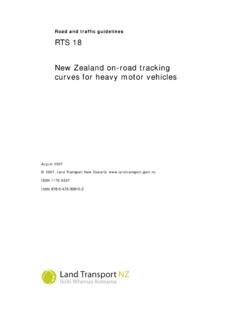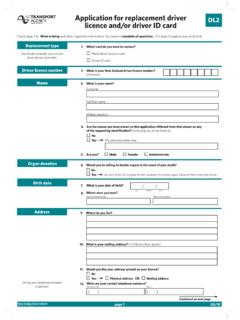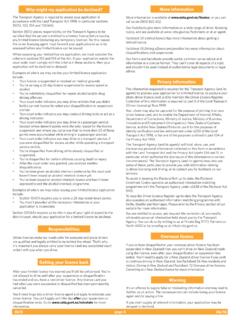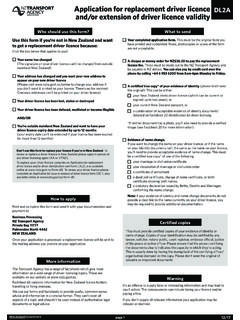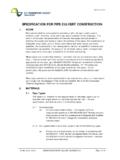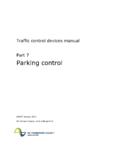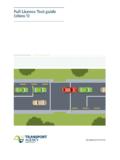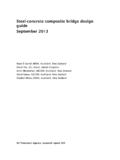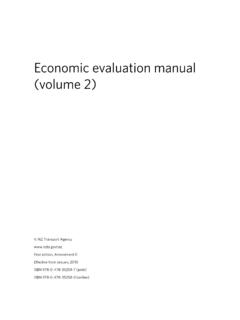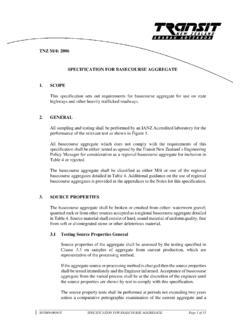Transcription of All workers and road users go home safe every day
1 New Zealand guide to temporary traffic management Introduction 7 March 2022 Draft for feedback All workers and road users go home safe every day Waka Kotahi NZ Transport Agency New Zealand guide to temporary traffic management - 2 Copyright information Copyright . This copyright work is licensed under the Creative Commons Attribution International licence. In essence, you are free to copy, distribute and adapt the work, as long as you attribute the work to Waka Kotahi NZ Transport Agency and abide by the other licence terms. To view a copy of this licence, visit Disclaimer The purpose of this guide is to help the TTM industry make decisions about what safe temporary traffic management looks like and suggests what may be considered reasonably practicable steps towards ensuring that risk is minimised for those using and working in road corridors.
2 The TTM industry is encouraged to make decisions as they see fit and to obtain their own advice. Waka Kotahi has endeavoured to ensure material in this document is technically accurate and reflects legal requirements. However, the document does not override governing legislation. Waka Kotahi does not accept liability for any consequences arising from the use of this document. If you are unsure whether the material is correct, you should refer directly to the relevant legislation and contact Waka Kotahi. More information Waka Kotahi NZ Transport Agency Published [month and year] ISBN [number] If you have further queries, call our contact centre on 0800 699 000 or write to us: Waka Kotahi NZ Transport Agency Private Bag 6995 Wellington 6141 This document is available on Waka Kotahi NZ Transport Agency s website at Contents 1.
3 Foreword .. 3 2. Using this guide .. 4 3. Strategic Context for the TTM System Why we implement TTM .. 5 Introduction .. 5 Legislation .. 5 National strategy .. 7 National Guides .. 8 Why we need TTM .. 9 Waka Kotahi NZ Transport Agency New Zealand guide to temporary traffic management - 3 1. Foreword Waka Kotahi is committed to road to Zero, a safer Aotearoa New Zealand where no one is killed or seriously injured on our roads. This vision extends to the importance of keeping our road workers and road users safe when temporary traffic management is required. We support an approach that considers, on each temporary traffic management site, the risks to people and how they could be kept safe. We believe every road worker should go home safely. That s why we ve been actively working with the sector, from construction and maintenance companies to roading providers and regulators like WorkSafe, on a joined-up approach to make a difference to road worker safety.
4 As we developed the new guide, we talked with a range of stakeholders including construction companies, local councils, and community groups to understand their road safety challenges and test the principles of the new guide. This latest draft of the new guide includes their feedback to date along with international practices to help improve safety on our roads. To help us finalise the guide, we re now proud to launch this draft edition of the New Zealand guide to temporary traffic management (NZGTTM) for wider comment and feedback. The emphasis on a risk-based approach clearly places people at the heart of how we manage temporary traffic. It will be useful for construction and maintenance programmes, events, emergency response and primary industry activities or any activity where a temporary road design is required.
5 While proven principles underpin the guide, the key change is providing more freedom to focus on managing safety risks. At the same time the guide makes decision making and accountability clearer. The guide s risk-based approach will require a new way of thinking and new way of doing things to keep everyone safe on our roads. It s going to take time to embed this new way of working and Waka Kotahi, as a sector leader and as a road controlling authority, is committed to helping you through the changes. I look forward to hearing your feedback and working with you on this journey. Vanessa Browne National Manager Programme and Standards Transport Services Waka Kotahi NZ Transport Agency Waka Kotahi NZ Transport Agency New Zealand guide to temporary traffic management - 4 2. Using this guide This is a best practice guide to aid with securing the safety of those using and working in a road corridor.
6 While not a mandatory code of practice, it s intended for use by persons conducting a business or undertaking (PCBUs) that fund, plan, or engage in activities on or near Aotearoa New Zealand roads. Use this guide alongside the WorkSafe road and Roadside Worker Health and Safety Good Practice Guide. Further background reading includes the Health and Safety at Work Act, Land Transport Management Act, Local Government Act, road to Zero strategy. Waka Kotahi NZ Transport Agency New Zealand guide to temporary traffic management - 5 3. Strategic Context for the TTM System Why we implement TTM Introduction Many of us know of a time where a worker or member of the public has died or been seriously injured at a worksite. We must all do everything we can to reduce deaths and serious harm. In Aotearoa New Zealand, legislation along with national strategy and guidance documents, requires that PCBU s must do all things reasonably practicable to keep workers and road users safe.
7 The core documents relating to worker safety from traffic risks have been referenced and summarised in this section Legislation Health and Safety at Work Act 2015 (HSWA) What HSWA sets out to do A good health and safety system relies on participation, leadership, and accountability from businesses, workers , and government. HSWA sets out the principles, duties, and rights in relation to workplace health and safety. Everyone needs to work together on health and safety. What are the key changes? HSWA makes everyone s roles and responsibilities clear. PCBU s are responsible for the health and safety of their workers and any other workers they influence or direct. They are also responsible for the health and safety of people at risk from the work they are doing. In this case, a PCBU is any entity that is controlling or impacting road workers and users .
8 Work-related health and safety risks must be identified and managed, so everyone is kept safe and healthy. This means looking for potential for work-related health conditions as well as the injuries that could occur. Everybody involved must proactively do everything they can to identify risks and put in place controls to eliminate or minimise the risks to workers and road users such as drivers, passengers, pedestrians, and cyclists. What this means for the temporary traffic management industry All parties are responsible, whether they are the client, designer or contractor from Director to CEO to manager to worker. Everybody has obligations to both workers and road users . Everyone gets the highest level of protection reasonably practicable. The convenience of road users , while important, should not be prioritised over the safety of road workers or users .
9 Everyone must have the best protection possible from workplace health and safety risks, as is reasonably practicable. Everyone is responsible for safety and health If you create the risk, you manage the risk Waka Kotahi NZ Transport Agency New Zealand guide to temporary traffic management - 6 Everyone needs to proactively identify risk and put in place controls to eliminate or minimise the risks as far as reasonably practicable. Land Transport Management Act 2003 (LTMA) The purpose of the LTMA The LTMA contributes to the aim of achieving an affordable, integrated, safe, responsive, and sustainable land transport system. The LTMA covers things like: establishing organisations such as Waka Kotahi NZ Transport Agency and Auckland Transport planning and investment in land transport consideration of options social and environmental outcomes funding mechanisms.
10 What this means for the temporary traffic management industry The TTM system is used by those who work on land transport funded projects to: contribute to a safer land transport system deliver projects that improve the safety of the transport system deliver projects in a safe manner. Local Government Act 2002 (LGA) The act provides for democratic and effective local government that recognises the diversity of Aotearoa New Zealand communities. The act: states the purpose of local government provides a framework and powers for local authorities to decide which activities they undertake and how they will undertake them promotes the accountability of local authorities to their communities provides for local authorities to promote the social, economic, environmental, and cultural well-being of their communities, using a sustainable development approach.
